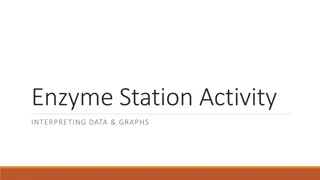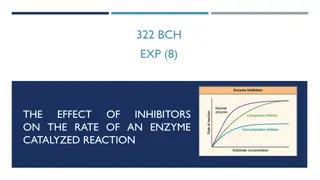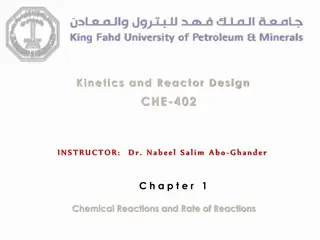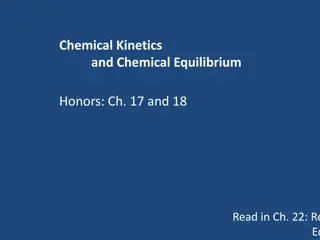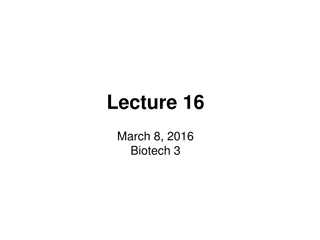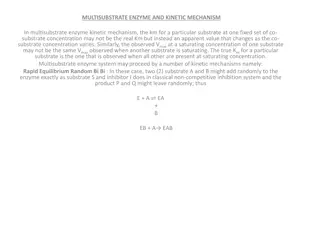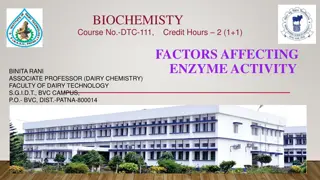Exploring Enzyme Kinetics for Understanding Chemical Reactions
Enzyme kinetics is a vital discipline focusing on the rate of enzyme-catalyzed reactions and how they respond to varying conditions. Reactions are classified based on reactant concentration influences. Zero, first, second, and third order reactions are distinguished, with examples like first-order reactions being proportional to reactant concentration. In enzyme-catalyzed reactions, the relationship between initial velocity and substrate concentration follows the Michaelis-Menten equation, displaying a hyperbolic pattern. Henri and Michaelis-Menten proposed kinetic models to explain these phenomena.
Download Presentation

Please find below an Image/Link to download the presentation.
The content on the website is provided AS IS for your information and personal use only. It may not be sold, licensed, or shared on other websites without obtaining consent from the author. Download presentation by click this link. If you encounter any issues during the download, it is possible that the publisher has removed the file from their server.
E N D
Presentation Transcript
(f) Enzyme Kinetics : The central approach to studying the mechanism of an enzyme-catalyzed reaction is to determine the rate of the reaction and how it changes in response to changes in experimental parameters, a discipline known as enzyme kinetics Chemical reactions may be classified on the basis of the number of molecules that react to form the reaction products. Chemical reactions are also classified on a kinetic basis, by reaction order : Zero order, First order, Second order & Third order, depending on how the reaction rate is influenced by the conc. of the reactants under a set of condition.
Kinetics of First and Zero order Reaction : First order reaction : are those which proceed at a rate exactly proportional to the conc. Of one reactant. e.g . When the rate of reaction A ------- exactly proportional to the conc. Of A. Then the reaction rate at any time t is given by First order reaction : - d [A]/dt = K [A] where [A] is the molar conc. of A and - d [A]/dt is the rate at which the conc. Of A decreases. K is the rate constant P is
Zero order reactions : Chemical reactions are independent of the conc. Of any reactant are called Zero order reactions. In this case rate of reaction depends on the conc. Of the catalysts or on some other factors. Reaction rates are often mixed order, not pure first or second order.
Kinetics of Single- Substrate Enzyme Catalysed Reactions The Relationship between Initial Velocity and Substrate Concentration : The Henri and Michaelis- Menten Equation : Experimental evidence showed that for many single substrate enzyme catalysed reactions, there was a Hyperbolic relationship between initial velocity Vo and initial substrate concentration [So] . Fig.
Kinetic models to explain these were proposed by Henri (1903) and Michaelis and Menten(1913). Let us consider single substrate enzyme catalysed reaction, where there is just one substrate binding site per enzyme. The simplest general equation for such reaction would be :
- At an early stage of reaction, the product conc. is negligible and the formation of ES from product can be ignored. - Under this conditions, reaction can be simplified to : - The rate of formation of ES at any time t = k1[E][S], where [E] is the conc. of free enzyme and [S] the conc. of free substrate at time t
- Also at time t , the rate of Breakdown of ES back E and S = k-1 [ES], Where [ES] is the conc. of enzyme - substrate complex at this time. - The Michaelis and Menten assumption was that an equilibrium between Enzyme, Substrate and Enzyme substrate complex was set up and maintained and the breakdown of ES complex to products being too slow to disturb this equilibrium. Therefore : k1 [E][S] = k-1 [ES]
-The constant may then be separated from the variables, giving : Where Ks is the Dissociation Constant of ES. -The total conc. of enzyme present [E0]must be the sum of the conc. of free enzyme [E] and the conc. of bound enzyme [ES]. Therefore, in order to involve total enzyme conc. in above equation, the following substitution is made :
- [ES] has been isolated in this way, because it governs the rate of formation of products. - According to relationship V0 = K2 [ES] If we substitute the expression for [ES] derived above, we obtain :
- we know that when the substrate is very high, all the enzyme is present as ES complex and the limiting velocity Vmax is reached. Under this conditions : V max = K2 [E0] Therefore , we can substitute V max for K2[E0] in the expression for V0and get :
- If we make the assumption that the initial substrate conc. [S0] is very much greater than the initial enzyme conc. [E0], then the formation of ES complex will result in an insignificant change in free substrate conc. Hence we can substitute [S0] for [S] in above equation, giving :
- This is an equation , which explain the experimental findings. - However, it is unsatisfactory, because equilibrium assumption can not be generally applicable. - As many enzyme catalyzed reactions are likely to proceed at rates fast enough to disturb such an equlibrium.
The Briggs- Haldane modification of the Michaelis- Menten Equation : The equation derived by Michaelis and Menten was modified by Briggs and Haldane (1925). - They introduced more generally valid assumption of the Steady State. - They argued that since the conc. of enzyme, and thus ES complex, was very small compared with the substrate conc.; the rate of change of [ES] would be negligible compared to the rate of change of [P] over the initial period of reaction.
In the absence of product, the conc.of ES would be determined by total enzyme conc.; which remain constant throughout and by the substrate conc.; which changes by negligible amount. So once the this complex is produced, would be maintained in a Steady State, i.e it would be broken down as fast as it was being formed, [ES] remaining constant.
- Rapid reaction studies have shown that, the Steady State is established within milliseconds of the start of the reaction and is maintained for a few minutes until the product conc.; and hence the rate of the reverse reaction becomes significant. - If we again consider a single substrate single binding site reaction :
- the rate of formation of ES at any time t = k1 [E] [S] - the rate of Breakdown of ES at this time = k-1 [ES] + k2 [ES] Using steady- state assumption : k1 [E] [S] = k-1 [ES] + k2 [ES] = [ES](k-1 + k2 ) Separating the constants from the variables : where Km is another constant
Finally, since the substrate conc. Is usually much greater than enzyme conc. ; [S] = [S0], so This is the same form as the equation derived by Michaelis and Menten, only the defination of constant has changed. Hence the equation has retained the name Michaelis and Menten equation and Km is called Michaelis constant.
- Km can also be obtained from the graph, when V0 = 2 Vmax
Therefore, Km is the value of [S0] which gives initial velocity equal to 2 Vmax. Km is called Michaelis Michaelis-Menten constant and is defined as the Substrate concentration at 2 Vmax in an enzyme catalysed reaction which can be expressed in mole/lit. Km value is constant and a characteristic feature of a given enzyme. lt is a representative for measuring the strength of ES complex.
A low Km value indicates a strong affinity between enzyme and substrate, whereas a high Km value reflects a weak affinity between them. For majority of enzymes, the Km values are in the range of 10 to 10 2 moles. lt may however, be noted that Km is not dependent on the concentration of enzvme.
Kcat - describe the limiting rate of any enzyme-catalyzed reaction at saturation. If the reaction has several steps and one is clearly rate limiting, kcat is equivalent to the rate constant for that limiting step. For the simple reaction : kcat = k2 The constant kcat is a first-order rate constant and hence has units of reciprocal time.
It is also called the turnover number. It is equivalent to the number of substrate molecules converted to product in a given unit of time on a single enzyme molecule when the enzyme is saturated with substrate.
This form of the Michaelis-Menten equation is called the Lineweaver-Burk equation. For enzymes obeying the Michaelis-Menten relationship, a plot of 1/V0 versus 1/[S] (the double reciprocal of the V0 versus [S] plot we have been using to this point) yields a straight line (Fig. 1). This line has a slope of Km/Vmax, an intercept of 1/Vmax on the 1/V0 axis, and an intercept of 1/Km on the 1/[S] axis.
The double-reciprocal presentation, also called a Lineweaver-Burk plot, has the great advantage of allowing a more accurate determination of Vmax, which can only be approximated from a simple plot of V0 versus [S]. The double-reciprocal plot of enzyme reaction rates is very useful in distinguishing between certain types of enzymatic reaction mechanisms and in analyzing enzyme inhibition










